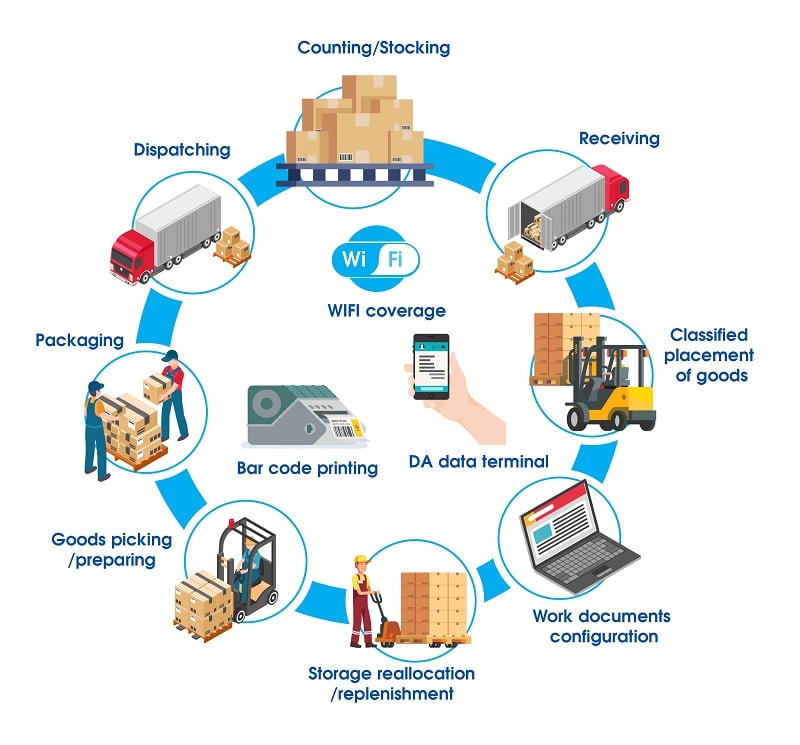Introduction to Warehouse Management: Key Principles and Best Practices
Warehouse management is a critical component of supply chain operations, playing a pivotal role in ensuring smooth and efficient business processes. Effective warehouse management systems (WMS) contribute to optimizing inventory levels, streamlining logistics, reducing operational costs, and ultimately enhancing customer satisfaction. In this article, we will explore the importance of warehouse management, the core components of a successful system, and best practices that can elevate the efficiency of any warehouse operation.

What is Warehouse Management?
Warehouse management refers to the process of overseeing and controlling the operations within a warehouse. It includes managing the storage, retrieval, and distribution of goods and products, ensuring that the right inventory is in the right place at the right time. Warehouse management involves a combination of technology, people, and processes to ensure the efficient flow of goods from receiving to shipping.
The goal of warehouse management is to optimize every aspect of warehouse operations, including inventory control, order fulfillment, and distribution. By doing so, businesses can reduce errors, minimize delays, and enhance productivity.
Key Components of Warehouse Management
Warehouse management involves several crucial components that work together to ensure smooth and efficient operations:
1. Inventory Control
Inventory control is at the heart of warehouse management. It involves monitoring the movement of goods in and out of the warehouse, ensuring that inventory levels are accurately tracked. Efficient inventory control helps prevent overstocking and stockouts, improving overall inventory accuracy.
Key aspects of inventory control include:
- Inventory tracking: Using technology such as RFID (Radio Frequency Identification) and barcode scanners to monitor inventory in real time.
- Replenishment: Ensuring that inventory is replenished based on demand patterns and lead times.
- FIFO (First In, First Out): Implementing FIFO practices to ensure older stock is used or shipped first, reducing the risk of expired goods or obsolete inventory.

2. Order Fulfillment
Order fulfillment involves the process of receiving, picking, packing, and shipping customer orders. It is crucial to streamline these processes to minimize delays and improve customer satisfaction. A warehouse management system (WMS) can automate several of these steps, reducing human error and speeding up the fulfillment cycle.
Key steps in order fulfillment include:
- Picking: Selecting the items that need to be shipped based on customer orders. This can be done manually or through automated systems.
- Packing: Ensuring that the items are packed securely and accurately to prevent damage during transit.
- Shipping: Coordinating the logistics to ensure timely delivery of orders.
3. Warehouse Layout and Design
A well-organized warehouse layout is essential for efficient operations. A well-designed warehouse reduces the time spent searching for products and improves safety. Key design principles include:
- Clear pathways: Ensure wide aisles and well-defined storage zones to reduce congestion and improve movement.
- Zoning: Group products according to their size, demand, or type for easy access and faster picking.
- Efficient shelving: Implement appropriate shelving and racking systems to maximize storage space and improve access.
4. Technology Integration
In today’s competitive business environment, the integration of technology is crucial to warehouse management success. Warehouse Management Systems (WMS) help automate and streamline tasks such as inventory tracking, order processing, and reporting. Additionally, technologies like robots, automated guided vehicles (AGVs), and drones can further optimize operations.
WMS solutions can provide real-time data on inventory levels, order status, and warehouse performance, enabling businesses to make informed decisions and improve operational efficiency.
Benefits of Effective Warehouse Management
Implementing an effective warehouse management system can bring several benefits to businesses, including:
1. Improved Efficiency and Productivity
A well-managed warehouse can reduce the time spent on tasks like product retrieval, packing, and shipping. With optimized processes, employees can work more efficiently, which translates into higher productivity and reduced operational costs.
2. Enhanced Inventory Accuracy
Accurate inventory tracking helps prevent overstocking, stockouts, and costly errors. By maintaining real-time data on inventory levels, businesses can ensure that they always have the right products on hand without the risk of excess inventory.
3. Better Customer Satisfaction
An efficient warehouse management system leads to faster order fulfillment and more accurate deliveries, improving customer satisfaction. Timely delivery of the correct products is essential for building customer loyalty.
4. Cost Savings
Streamlining warehouse operations helps businesses reduce operational costs. By minimizing errors, reducing storage costs, and optimizing inventory levels, warehouses can significantly improve their bottom line.

Warehouse Management Best Practices
To maximize the effectiveness of warehouse operations, businesses should follow several best practices:
1. Use Technology to Automate Tasks
Automation can significantly improve warehouse efficiency. Implementing Warehouse Management Systems (WMS), barcode scanners, and automated picking systems can help reduce human error, speed up operations, and ensure accurate inventory tracking.
2. Invest in Employee Training
Employees play a critical role in warehouse management, so investing in their training is essential. Proper training ensures that workers are familiar with safety protocols, inventory management practices, and the use of technology. A well-trained workforce can help improve productivity and reduce mistakes.
3. Optimize Warehouse Layout
Reviewing and optimizing warehouse layout regularly is key to maintaining an efficient warehouse. This includes analyzing the flow of goods, adjusting storage space as needed, and reorganizing zones based on the demand for specific products.
4. Regularly Review Inventory Levels
To maintain accurate inventory levels, businesses should regularly audit and reconcile stock. This can be done through cycle counts (periodic counting of a small subset of inventory) or full inventory audits. Accurate inventory tracking helps avoid stockouts, overstocking, and other issues that can disrupt operations.
5. Monitor Key Performance Indicators (KPIs)
Monitoring KPIs such as order accuracy, inventory turnover, and order cycle time helps businesses track the efficiency of their warehouse operations. By reviewing these metrics, warehouse managers can identify areas for improvement and make data-driven decisions.
Common Challenges in Warehouse Management
While warehouse management can bring significant benefits, it also comes with its challenges. Some common hurdles include:
- Space limitations: Warehouses can quickly become crowded, making it difficult to store inventory efficiently. This can lead to delays and inefficient picking processes.
- Inventory discrepancies: Mistakes in inventory tracking can lead to discrepancies between actual stock levels and recorded levels. This can result in stockouts or overstocking.
- Labor shortages: Finding and retaining skilled warehouse workers can be challenging, especially in a competitive labor market.
- Technological integration: While technology can streamline operations, implementing and maintaining advanced systems like WMS can be costly and require specialized knowledge.
FAQs About Warehouse Management
1. What is the primary goal of warehouse management?
The primary goal of warehouse management is to ensure the efficient and cost-effective handling of inventory and orders, ultimately contributing to a smoother supply chain and better customer satisfaction.
2. How does a Warehouse Management System (WMS) work?
A WMS automates and streamlines various warehouse functions such as inventory tracking, order fulfillment, and reporting. It helps improve accuracy, reduce errors, and optimize warehouse operations by providing real-time data and analysis.
3. What are the main benefits of good warehouse layout?
A well-designed warehouse layout improves efficiency by reducing the time spent moving goods. It also helps with safety, reduces congestion, and enhances overall productivity.
4. How can warehouse managers reduce operational costs?
By optimizing inventory levels, automating tasks, improving employee training, and monitoring performance metrics, warehouse managers can reduce operational costs and improve overall efficiency.
Conclusion
Effective warehouse management is crucial for businesses aiming to improve operational efficiency, reduce costs, and enhance customer satisfaction. By implementing a well-organized inventory control system, optimizing order fulfillment processes, and integrating technology, businesses can ensure that their warehouse operations run smoothly and contribute to the overall success of the supply chain.
For more information on warehouse management systems and best practices, visit:
– Control Systems for Warehouse Management
– Warehouse Logistics Training

